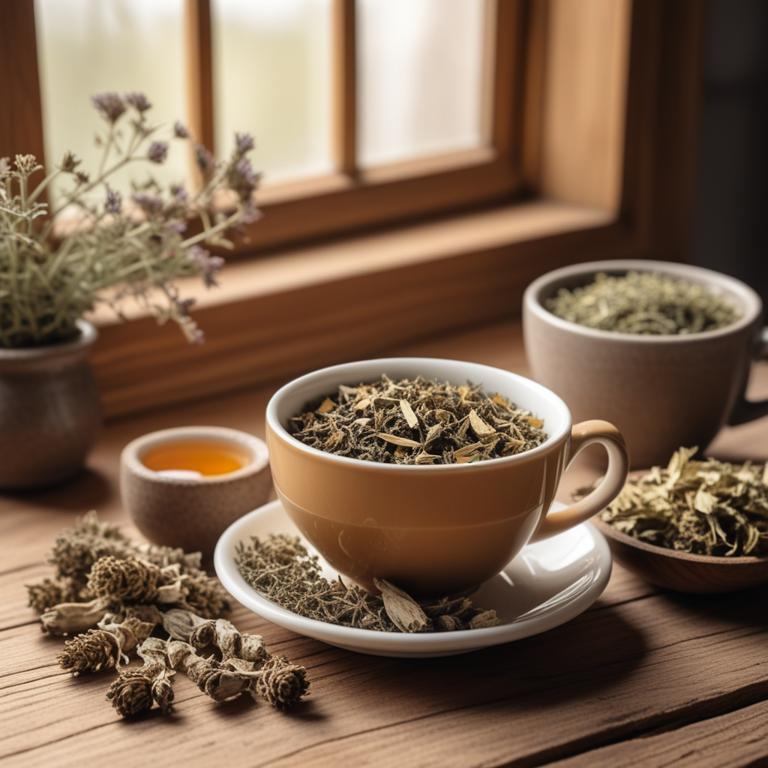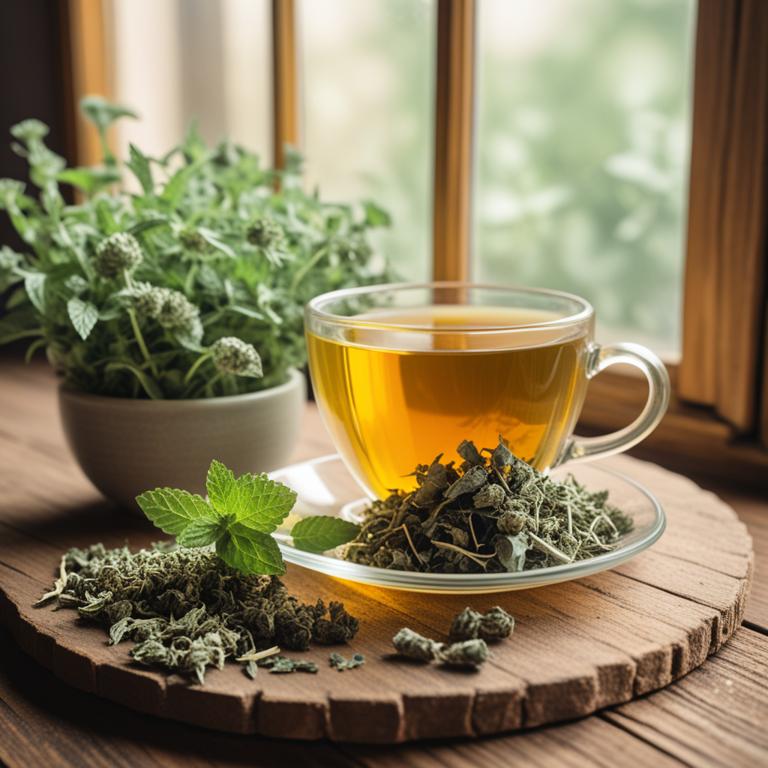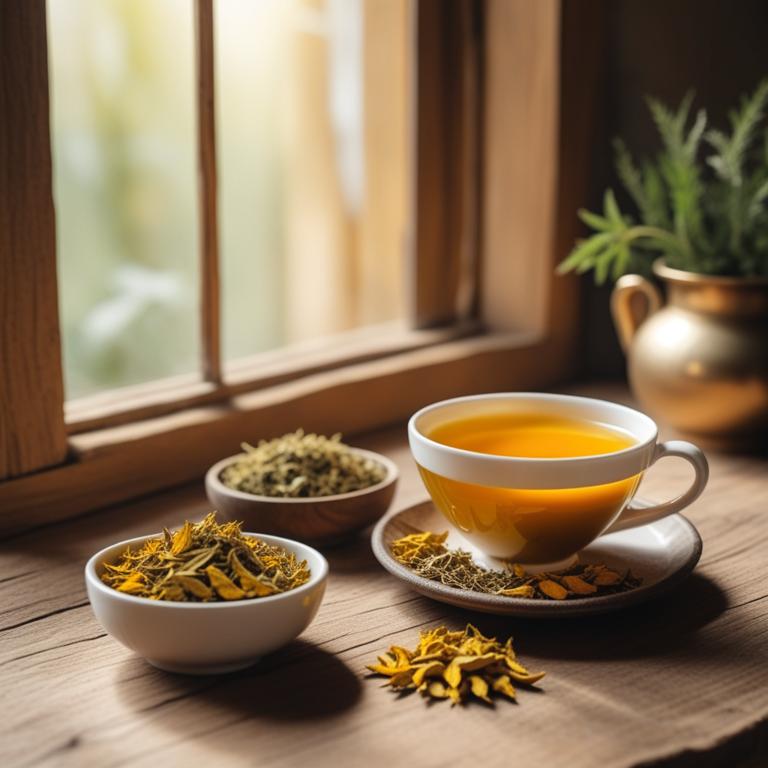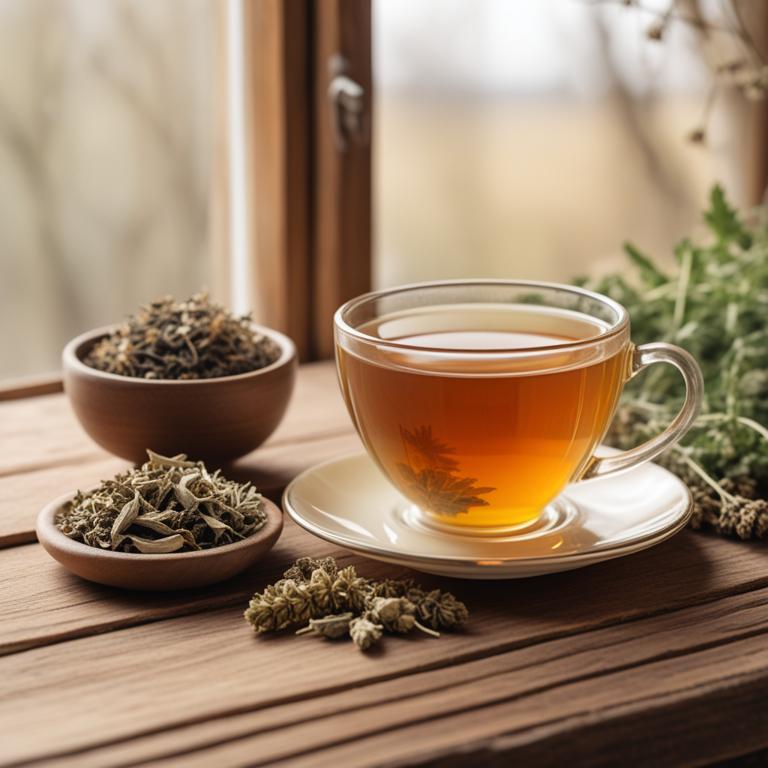9 Best Herbal Teas For Abdominal Pain

Herbal teas for abdominal pain are natural remedies made from various plant extracts that help alleviate discomfort and inflammation in the abdominal region.
These teas offer numerous benefits, including reducing inflammation, soothing digestive issues, and promoting relaxation, making them a popular alternative to conventional medication.
Examples of herbal teas used to treat abdominal pain include peppermint tea, which eases indigestion and nausea; ginger tea, which reduces inflammation and nausea; chamomile tea, which calms the digestive system and promotes relaxation; dandelion root tea, which supports liver function and reduces bloating; and licorice root tea, which soothes the stomach lining and reduces inflammation.
By incorporating these herbal teas into their regimen, individuals can find relief from abdominal pain and promote overall digestive health.
According to "Current drug discovery technologies", teas for abdominal pain may be an effective option due to the antioxidant and anti-inflammatory properties of green tea, particularly its major phytochemical component, Epigallocatechin-3-gallate (EGCG).
Below there's a list of the 9 best herbal teas for abdominal pain.
- 1. Mentha x piperita teas
- 2. Rosmarinus officinalis teas
- 3. Zingiber officinale teas
- 4. Curcuma longa teas
- 5. Silybum marianum teas
- 6. Glycyrrhiza glabra teas
- 7. Cinchona officinalis teas
- 8. Cinnamomum verum teas
- 9. Citrus reticulata teas
Also you may be interested in...
TODAY'S FREE BOUNDLE
Herb Drying Checklist + Herbal Tea Shopping List + Medicinal Herbs Flashcards
Enter you best email address below to receive this bundle (3 product valued $19.95) for FREE + exclusive access to The Aphotecary Letter.
$19.95 -> $0.00
1. Mentha x piperita teas

Mentha x piperita teas, also known as peppermint tea, have been traditionally used to treat abdominal pain due to its anti-inflammatory and antispasmodic properties.
The herbal preparation helps to treat this ailment by relaxing the muscles in the digestive tract, reducing inflammation and soothing the digestive system, thereby providing relief from abdominal pain.
The bioactive constituents of peppermint tea, including menthol, menthone, and limonene, contribute to its therapeutic effects by inhibiting the release of pain-causing chemicals and reducing muscle spasms.
The benefits of using peppermint tea to treat abdominal pain include its non-addictive and non-irritating nature, making it a safe and effective herbal remedy for alleviating digestive discomfort.
Related Study
According to "Phytotherapy research : PTR", Mentha x piperita teas for abdominal pain have demonstrated significant relaxation effects on gastrointestinal (GI) tissue in animal model studies, indicating potential relief from abdominal pain.
2. Rosmarinus officinalis teas

Rosmarinus officinalis teas have been traditionally used to treat abdominal pain due to their anti-inflammatory, antispasmodic, and carminative properties.
The bioactive constituents, such as carnosic acid and rosmarinic acid, help to reduce inflammation and relax smooth muscle in the digestive tract, providing relief from abdominal pain.
By reducing inflammation and promoting digestion, Rosmarinus officinalis teas can help to alleviate symptoms associated with abdominal pain, including cramps and bloating.
The benefits of using Rosmarinus officinalis teas to treat abdominal pain include reduced reliance on pharmaceuticals, improved digestion, and a natural approach to managing symptoms.
Related Study
According to the given study, Rosmarinus officinalis teas for abdominal pain may offer potential benefits as part of the herbal remedies that could enhance the digestive system and alleviate pain and discomfort.
3. Zingiber officinale teas

Zingiber officinale teas, derived from the rhizome of the ginger plant, have been traditionally used to treat abdominal pain, particularly in cases of nausea, indigestion, and irritable bowel syndrome.
The anti-inflammatory and antioxidant properties of these teas help to reduce inflammation and soothe the digestive tract, providing relief from abdominal discomfort.
The bioactive constituents, including gingerols and shogaols, are responsible for these therapeutic effects, as they inhibit the production of prostaglandins, which contribute to pain and inflammation.
The benefits of using Zingiber officinale teas to treat abdominal pain include rapid relief from symptoms, improved digestion, and reduced risk of complications associated with prolonged inflammation.
Related Study
According to "BioFactors (Oxford, England)", Zingiber officinale teas for abdominal pain may be beneficial due to their anti-inflammatory properties, which include inhibition of the NF-κB, STATs, NLRPs, TLRs, MAPKs, and mTOR pathways, as well as inhibiting various pro-inflammatory cytokines.
4. Curcuma longa teas

Curcuma longa teas have been traditionally used to treat abdominal pain, particularly in cases of irritable bowel syndrome (IBS) and gastrointestinal disorders.
The anti-inflammatory and antioxidant properties of this herbal preparation help to reduce inflammation and soothe the digestive tract, providing relief from abdominal pain and discomfort.
The bioactive constituents, including curcumin, demethoxycurcumin, and bisdemethoxycurcumin, exhibit potent anti-inflammatory and antioxidant activities, which contribute to their therapeutic effects.
Regular consumption of Curcuma longa teas has been found to provide benefits in reducing abdominal pain and improving overall digestive health, making it a potential natural remedy for those suffering from this condition.
Related Study
According to "Journal of gastrointestinal and liver diseases : JGLD", Curcuma longa teas, specifically the combination of curcumin and fennel essential oil, may be effective in relieving abdominal pain in patients with Irritable Bowel Syndrome (IBS), as it induced a significant decrease in abdominal pain and all other IBS symptoms after 30 days of treatment.
5. Silybum marianum teas

Silybum marianum teas, also known as milk thistle teas, have been traditionally used to treat abdominal pain, particularly related to liver and gallbladder issues.
This herbal preparation helps to treat abdominal pain by its anti-inflammatory and antioxidant properties, which soothe and calm the digestive system.
The bioactive constituents of Silybum marianum teas, including silymarin and flavonoids, help to protect the liver cells and improve its function, thereby reducing abdominal pain and discomfort.
The benefits of using Silybum marianum teas to treat abdominal pain include reduced inflammation, improved digestion, and enhanced liver health, making it a popular natural remedy for this ailment.
6. Glycyrrhiza glabra teas

Glycyrrhiza glabra teas have been traditionally used to treat abdominal pain due to their anti-inflammatory, antispasmodic, and carminative properties, which help to soothe and relax the digestive tract.
The bioactive constituents, including glycyrrhizin, flavonoids, and phenolic acids, possess analgesic and anti-inflammatory properties, thereby reducing pain and inflammation in the abdominal region.
By reducing spasms and inflammation, Glycyrrhiza glabra teas help to alleviate abdominal pain and discomfort, allowing for improved digestion and bowel regularity.
The benefits of using Glycyrrhiza glabra teas to treat abdominal pain include reduced pain and discomfort, improved digestive health, and a natural approach to managing symptoms without the risk of side effects associated with pharmaceutical medications.
Related Study
According to "Current pharmaceutical biotechnology", Glycyrrhiza glabra teas for abdominal pain may be beneficial in managing visceral hypersensitivity, particularly in irritable bowel syndrome (IBS), due to its anti-inflammatory and antioxidant properties.
7. Cinchona officinalis teas

Cinchona officinalis teas, derived from the Cinchona tree, have been traditionally used to treat abdominal pain, particularly for conditions such as malaria and fever.
The properties of this herbal preparation, including its anti-inflammatory and antipyretic properties, help to alleviate abdominal pain by reducing inflammation and fever.
The bioactive constituents, including quinine and alkaloids, play a crucial role in treating abdominal pain by inhibiting the production of prostaglandins, which are responsible for pain and inflammation.
The benefits of using Cinchona officinalis teas to treat abdominal pain include reduced pain and discomfort, as well as a natural and non-addictive alternative to conventional pain medications.
8. Cinnamomum verum teas

Cinnamomum verum teas have been traditionally used to treat abdominal pain due to their anti-inflammatory and carminative properties.
This herbal preparation helps to treat abdominal pain by reducing inflammation, relieving spasms, and promoting digestion.
The bioactive constituents of Cinnamomum verum teas, including cinnamaldehyde and linalool, are responsible for its analgesic and antispasmodic effects, which help to alleviate abdominal pain.
The benefits of using Cinnamomum verum teas to treat abdominal pain include reduced discomfort, improved digestion, and a natural alternative to pharmaceutical medications.
9. Citrus reticulata teas

Citrus reticulata teas, derived from the peel of the mandarin orange, have been traditionally used to treat abdominal pain due to their anti-inflammatory and carminative properties.
The herbal preparation helps to treat this ailment by relieving digestive discomfort, reducing spasms, and soothing the stomach lining.
The bioactive constituents of Citrus reticulata teas, including limonoids, flavonoids, and terpenes, contribute to its therapeutic effects, which aid in reducing inflammation and alleviating pain.
Regular consumption of Citrus reticulata teas has been found to provide relief from abdominal pain, promote digestive health, and offer a natural remedy for those seeking alternative treatments.